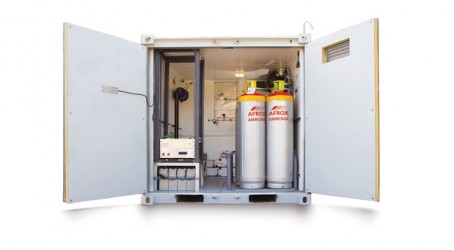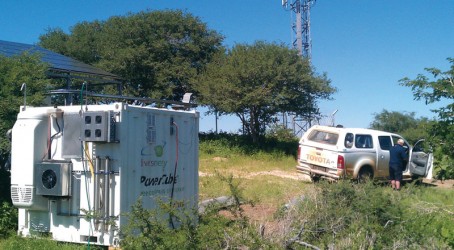A small British firm is delivering big advantages in Africa with fuel-cell technology that is helping to provide reliable mobile phone coverage across wide areas of rural locations.
West Sussex-based Diverse Energy has developed an off-grid generating system, for back-up and prime power, which uses widely available ammonia as its only fuel. So far the PowerCube has been installed in Botswana, Namibia and South Africa, and is helping to drive mobile phone adoption by bolstering signal coverage in isolated areas.
“To create a mobile phone signal coverage area, you need a base station, which in turn needs a sizeable and reliable electricity supply,” says Dr Mike Rendall, chief technology officer at Diverse Energy. “The geographical coverage area produced by a single base station is limited, so a country requires a network of base stations to provide adequate mobile phone signal coverage, which in turn requires a distributed and maintainable supply of electricity.
“The energy grid in Africa is anything but distributed or reliable, and rural areas suffer the worst conditions. In the relatively few locations where the grid is available, it is often only powered on for a few hours a day and is not dependable during that short time.”
Diesel generators have been suggested to fix this problem, but Rendall says that this is far from an ideal solution. “Diesel generators are noisy and inefficient when run at part loads,” he says. “They also require regular maintenance in the form of oil changes every 300 hours due to their moving parts. On top of that, they simply are not an environmentally friendly solution because they emit particulate soot and sulphur into the local atmosphere. Another problem is that diesel generators and their local fuel stores are highly resaleable, which makes them prime targets for theft, especially in remote areas.”
Diverse Energy’s PowerCube solution replaces the diesel generator with proton exchange membrane fuel-cell technology, which takes ammonia and converts it into electricity with zero local carbon emissions. The PowerCube reforms the ammonia into hydrogen and nitrogen, separating the hydrogen from the mixed gas stream, and passing the pure hydrogen stream to a fuel cell to produce electricity and pure water. The technology provides up to 1.2kW of DC power – at 24V or 48V – which is used to provide permanent baseload supply for mobile base transceiver stations.
Rendall says PowerCube can be fuelled by readily available anhydrous ammonia, an agricultural and refrigerant feedstock. It requires only monthly refuelling and quarterly servicing. The system is efficient at a range of power levels and each installation’s performance can be monitored remotely.
Rendall and his team quickly realised that, if the product was to prove successful in Africa, it needed to be reliable. “We’ve made the PowerCube as simple as we possibly could,” he says. “In Africa, you haven’t got access to the sorts of electrical components that you take for granted in Europe. If you need to get a fuse, you have to take it with you. There often isn’t a local supply counter from where you can get bits in an emergency.”


That ethos of simplicity has fed into the evolution of the PowerCube’s design. “For instance, we moved the ammonia cylinders around to ensure that the PowerCube is ventilated through natural convection movements rather than having a fan, which means we don’t have to worry about bearings,” he says. “The most recent design is significantly simpler than our earlier model: it has fewer joints, it is easier to transport, it is easier to install. And yet it still does exactly the same job.”
The performance of the PowerCube can be monitored remotely from the UK. Each cube has a modem in it, enabling it to dial out via the network infrastructure to broadcast data to Diverse Energy’s servers. “It gives us a record of every measured parameter and we can send commands back to make any changes or resettings. It all guarantees uptime – and with some cubes being 700km apart it’s crucial that the operator doesn’t have to keep going out to check on them.”
The most recent field trials took place in Namibia, where four PowerCubes were installed in and around the capital city of Windhoek. Over three months, all four were subjected to the extremes of Namibia’s climate conditions, topography and varying power and logistical demands.
The PowerCubes were supporting mobile telephone radio equipment owned and maintained by two firms – MTC and Leo. The sites had different existing power delivery systems. That gave Diverse Energy the opportunity to integrate its technology as a prime power source to replace existing systems and/or as a back-up source.
In the trials, existing systems ranged from grid electricity through to solar and wind technologies. For example, on a mountain site within a game park 20 miles north of Windhoek, a PowerCube came online in March to provide back-up power to a solar/battery hybrid system. This rural base station required 1.5kW, which the solar/battery solution failed to supply continuously.
Resulting radio downtime owing to low solar power was in excess of 27%, with more than 250 alarms triggered every month.
As the sun fell each night, the available light gradually diminished, reducing the power generated by the solar panel. Because of deep discharging, the battery array was severely depleted, with the operator facing the prospect of costly and regular battery replacements. With the radio load remaining relatively unchanged overnight, the defective battery array was unable to power the cell site radio infrastructure during hours of darkness.
The PowerCube was configured to operate in a constant voltage dynamic load following mode, gradually increasing its output to support the radio load as the battery charge was depleted. As a result, the sum of the powers from the PowerCube and the battery exactly matched the required load, with the PowerCube operating automatically based on demand.
Throughout the field trial, the PowerCube achieved continuous radio operation, says Rendall.
The trials showed that, at sites spanning desert and mountain locations, MTC and Leo achieved cost savings ranging from 20% to 60% against conventional diesel systems as a result of improved power efficiency levels and reduced numbers of fuelling and maintenance visits.
“We were delighted by the trials in Africa and in other parts of the world,” says Rendall. “The PowerCubes have been proved to work in 45ºC desert conditions, through to UK winter with snow on the ground, with no changes to performance.
“Some of the biggest problems we had in Africa were with wildlife: we came back a couple of times to see that the reason our radio had gone down was because baboons had stolen our aerials. Most of our kit is contained in what is effectively a shipping container, making it pretty secure.”
The plan now is to improve the output of the PowerCube while keeping the cost the same. Rendall also wants to supply the equipment to other countries.
“The cubes are made at our sites in Horsham, West Sussex, and our plan is to grow the company in other markets at a sensible rate to become a British manufacturing success story,” he says.